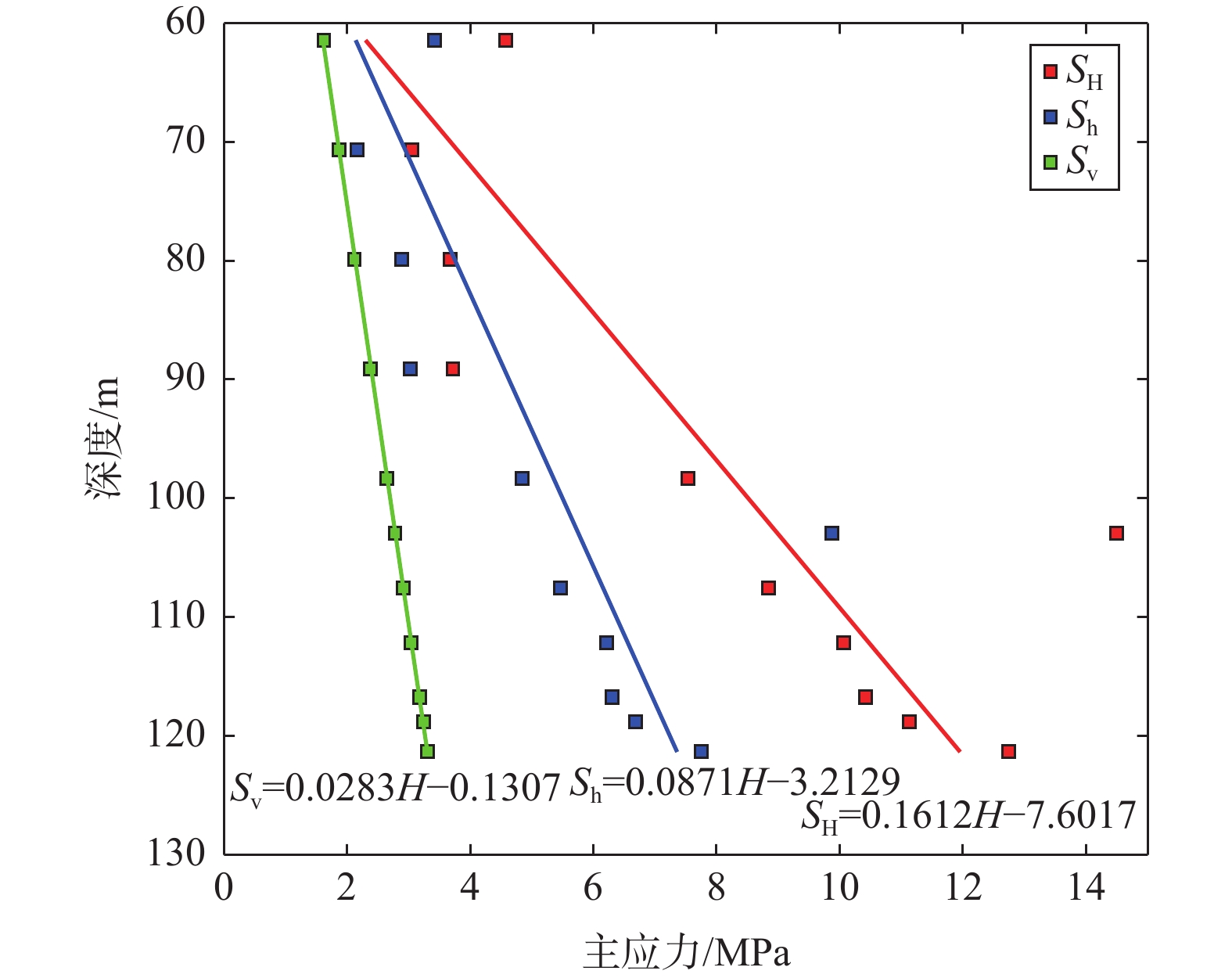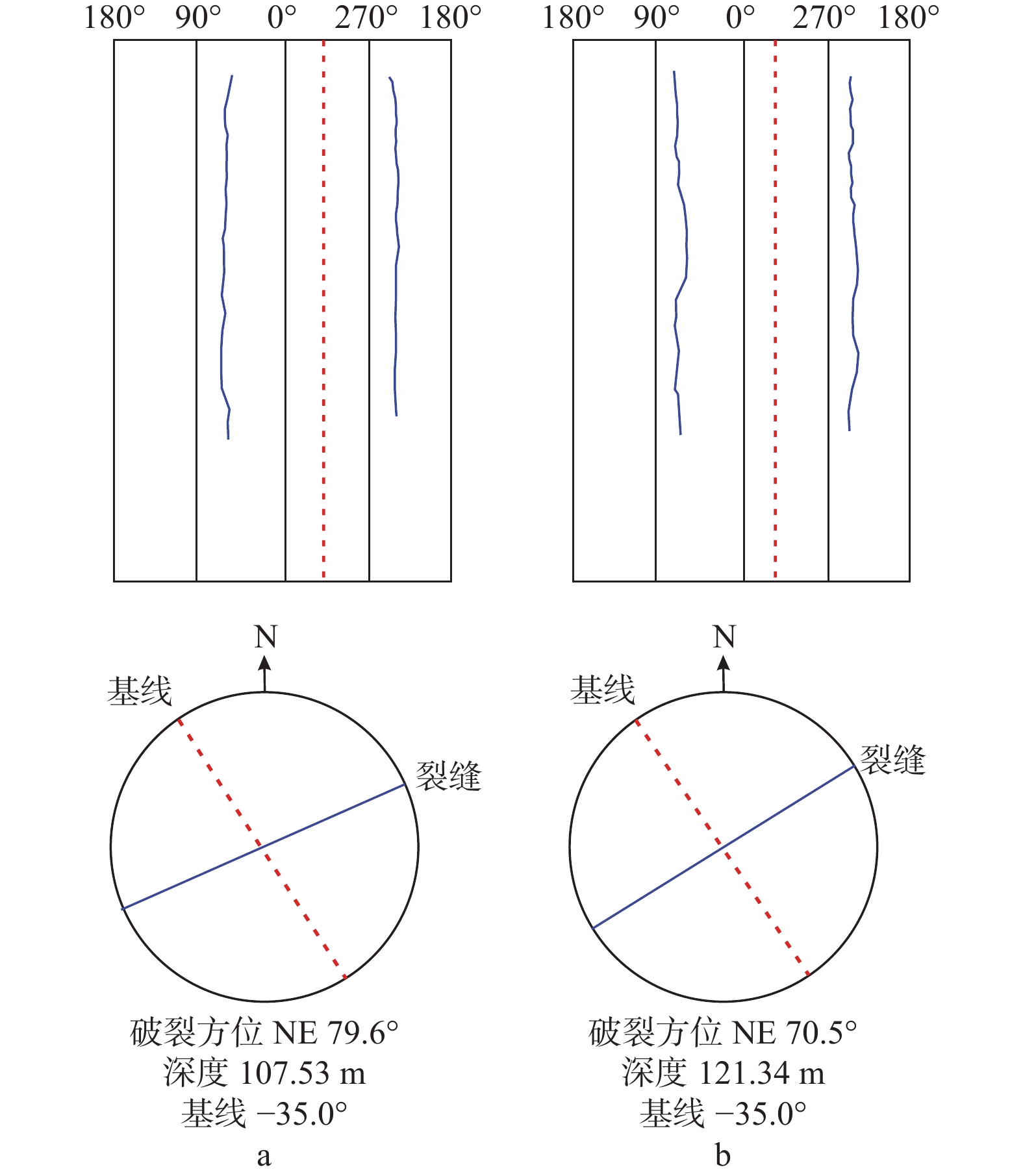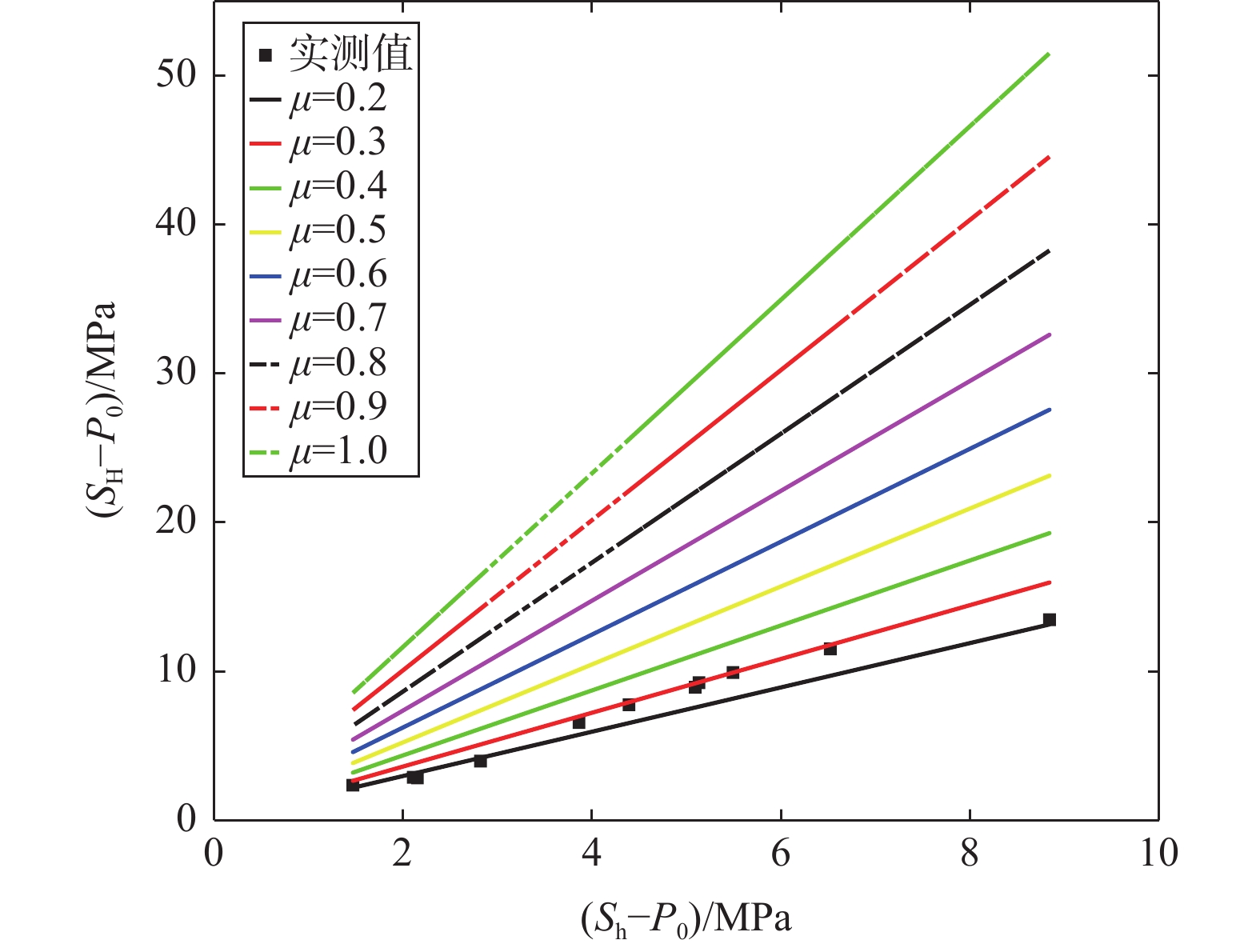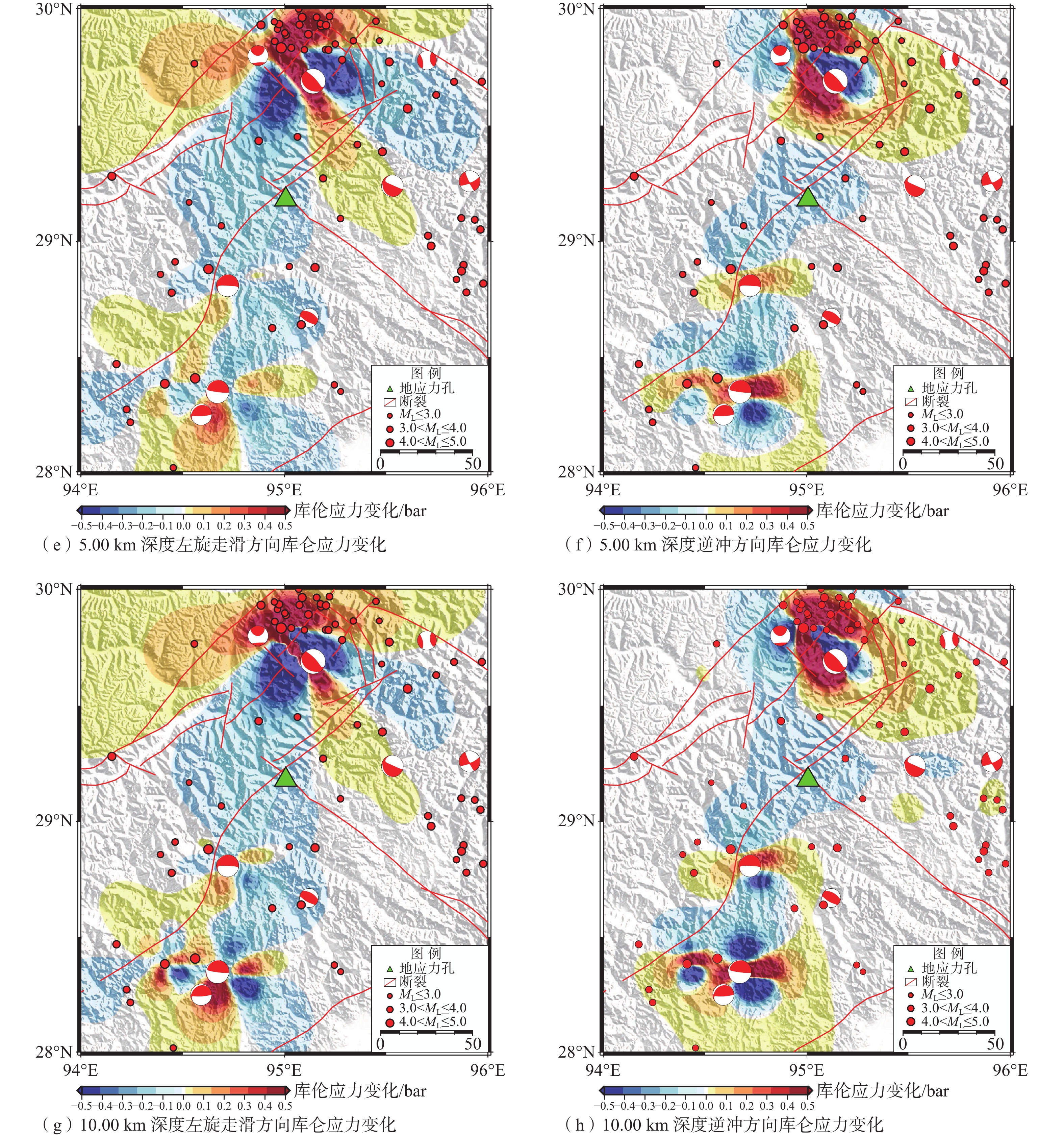Analysis of in-situ stress field characteristics and tectonic stability in the Motuo key area of the eastern Himalayan syntaxis
-
摘要:
为获取东构造结关键构造部位地应力特征、分析其构造稳定性,采用水压致裂法开展了墨脱断裂带西让段1个地应力孔、11个测试段的原位地应力测量工作。结果表明:61.43~121.34 m测试段最大、最小水平主应力值(SH、Sh)分别为3.05~14.50 MPa和2.16~9.87 MPa,垂向主应力值(Sv)为1.63~3.31 MPa,即SH>Sh>Sv;测点处应力场以水平挤压作用为主,均处于逆断层应力状态,且其主应力值随深度增加而逐渐增大,测点的最大水平主应力优势方位为北东东向;在整个地应力测量深度范围内,侧压系数值(Kav)为1.39~4.38,最大水平应力系数值(KHv)均大于1,且比值随深度的增加而增大,该关键部位区域应力场以水平应力为主导,方向性较强,所有测试段水平应力系数值(KHh)为1.23~1.66,与林芝−通麦段地应力特征参数计算结果基本相似;测点位置98 m以浅地层水平构造应力作用程度较小,应力积累水平较低,保持断层稳定所需的摩擦系数值小于实际断层的临界摩擦系数值,构造环境相对稳定,超过98 m深度地层由于水平构造应力起主要作用,保持断层稳定所需的摩擦系数值接近于实际断层的临界摩擦系数值,存在小概率发生断层失稳滑动的风险;区域强震在墨脱断裂带断层面上造成的左旋走滑方向上及逆冲方向上的库仑应力变化值的叠加量均为负值,抑制了断层的滑动,未能增加墨脱关键区域断层活动的危险性。
Abstract:In order to obtain the in-situ stress field characteristics and analyze tectonic stability in the Motuo key area of the eastern Himalayan syntaxis, the in-situ stress measurement of one in-situ stress hole and 11 test sections of the Xirang section of the Motuo fault zone were carried out by the hydraulic fracturing method. The results show that the maximum and minimum horizontal principal stress values (SH, Sh) in the test section of 61.43−121.34 m are 3.05−14.50 MPa and 2.16−9.87 MPa, respectively, and the vertical principal stress values (Sv) are 1.63−3.31 MPa, namely, SH>Sh>Sv. The in-situ stress field at the measuring point is dominated by horizontal compression, and all of them belong to the in-situ stress state of reverse fault. The principal stress values gradually increase with the increase of depth, and the dominant direction of the maximum principal stress is NEE. In the whole range of in-situ stress depth, the lateral pressure coefficients (Kav) are 1.39−4.38, the maximum horizontal stress coefficients (KHv) are greater than 1, and the ratio increases with the increase of depth. The regional stress field of this key area is dominated by horizontal stress and it is highly directional. The horizontal stress coefficients (KHh) of all test sections are 1.23−1.66, which are similar to the calculation results of in-situ stress characteristic parameters in Linzhi−Tongmai section. The horizontal tectonic stress of the shallow level at 98 m is relatively small, and the stress accumulation level is low. The friction coefficient required to maintain fault stability is smaller than the critical friction coefficient of actual fault, and the tectonic environment is relatively stable. When the depth exceeds 98 m, the friction coefficient required to maintain fault stability is close to the critical friction coefficient value of the actual fault due to the dominant role of horizontal tectonic stress, and there is a small risk of fault instability slip. The superposition of the Coulomb stress change in the sinistral strike-slip direction and the thrust direction caused by the strong regional earthquakes on the fault plane of the Motuo fault zone in the study area are all negative numbers, which inhibits fault slip and does not increase the risk of fault activity in the study area.
-
图 7 研究区及附近区域断层面在区域强震影响下不同深度处左旋走滑和逆冲库仑应力变化图(沙滩球表示地震的震源机制解)
Figure 7. Variation of sinistral strike-slip and thrust Coulomb stress at different depths (a–h) on the fault plane in the study area and nearby area under the influence of regional strong earthquakes (The beach balls represent the source mechanism of the earthquake)
表 1 水压致裂地应力测量结果
Table 1. Results of hydraulic fracturing in-situ stress measurement
测段深
度/m破裂压力
Pb/MPa重张压力
Pr/MPa瞬时关泵压力
Ps/MPa抗拉强度
T/MPa孔隙水压力
P0/MPa最大水平主应力
SH/MPa最小水平主应力
Sh/MPa垂向主应力
Sv/MPa最大主应力
方向61.43 5.03 4.48 2.22 0.55 0.60 4.58 3.42 1.63 70.65 2.73 2.45 1.47 0.68 0.69 3.05 2.16 1.87 79.87 3.85 3.43 2.11 0.42 0.78 3.68 2.89 2.12 89.09 7.48 4.61 2.45 3.97 0.88 3.72 3.03 2.38 98.31 8.64 7.52 3.86 3.62 0.98 7.54 4.84 2.65 102.92 16.27 14.25 8.84 3.22 1.03 14.50 9.87 2.78 107.53 6.55 5.41 2.39 1.74 1.08 8.84 5.47 2.91 NE79.6° 112.14 8.91 6.35 4.09 2.56 1.13 10.06 6.22 3.04 116.74 9.81 6.16 4.13 3.65 1.18 10.42 6.31 3.18 118.84 13.46 6.54 6.49 6.92 1.20 11.13 6.69 3.24 121.34 12.07 8.46 6.53 4.01 1.23 12.74 7.75 3.31 NE70.5° 注:地应力测量孔静水位为9.60 m 表 2 墨脱地应力孔水压致裂主应力间的变化规律
Table 2. Variation law of hydraulic fracturing principal stress in the Motuo in-situ stress hole
H/m Kav KHh KHv 61.43 2.46 1.34 2.82 70.65 1.39 1.41 1.63 79.87 1.55 1.27 1.73 89.09 1.42 1.23 1.57 98.31 2.34 1.56 2.85 102.92 4.38 1.47 5.21 107.53 2.46 1.62 3.04 112.14 2.68 1.62 3.31 116.74 2.63 1.65 3.28 118.84 2.75 1.66 3.44 121.34 3.10 1.64 3.85 表 3 研究区的附近区域强震的震源机制
Table 3. Focal mechanism of the strong earthquakes in the vicinity of the study area
日期 经度 纬度 深度 震级 走向1 倾角1 滑动角1 走向2 倾角2 滑动角2 破裂面长度 位错量/走滑 位错量/逆冲 1985-08-01 95.53°E 29.24°N 40.0 km MW5.7 176° 15° 153° 292° 83° 76° 6.49 km 0.102 m 0.408 m 1988-01-25 94.87°E 29.80°N 33.0 km MW5.2 37° 69° 159° 135° 71° 23° 3.84 km 0.164 m 0.063 m 2003-08-18 95.91°E 29.26°N 33.0 km MW5.5 65° 77° −6° 156° 84° −167° 6.10 km 0.237 m 0.025 m 2004-09-27 95.70°E 29.78°N 31.1 km MW4.9 126° 79° −176° 35° 86° −11° 2.41 km 0.129 m 0.009 m 2005-06-01 94.72°E 28.81°N 19.0 km MW5.8 209° 6° 26° 93° 87° 95° 7.57 km 0.040 m 0.451 m 2013-04-16 95.12°E 28.67°N 39.6 km MW4.9 300° 39° 90° 120° 51° 90° 1.88 km 0.000 m 0.236 m 2017-11-17 95.14°E 29.69°N 12.0 km MW6.5 119° 24° 72° 318° 67° 98° 22.34 km 0.105 m 0.746 m 2019-04-23 94.67°E 28.35°N 16.1 km MW6.1 208° 9° 21° 97° 87° 99° 12.04 km 0.088 m 0.557 m 2022-11-10 94.41°E 28.38°N 15.0 km MW5.6 226° 10° 43° 93° 83° 97° 5.56 km 0.048 m 0.389 m 表 4 通过地应力实测结果推算研究区墨脱断裂带断层面上的应力值
Table 4. Estimation of the stress values on the fault plane of the Motuo fault zone in the study area based on the measured results of in-situ stress
深度/
m最大水平主
应力SH/MPa最小水平主
应力Sh/MPa垂向主应力
Sv/MPa正应力
σ/MPa剪应力
τ/MPa剪应力
τ’
/MPa61.43 4.58 3.42 1.63 3.16 4.04 0.71 70.65 3.05 2.16 1.87 2.16 2.70 1.14 79.87 3.68 2.89 2.12 2.80 3.24 1.22 89.09 3.72 3.03 2.38 2.95 3.27 1.41 98.31 7.54 4.84 2.65 4.60 6.71 1.28 102.92 14.50 9.87 2.78 8.86 12.87 0.47 107.53 8.84 5.47 2.91 5.20 7.88 1.37 112.14 10.06 6.22 3.04 5.86 8.97 1.34 116.74 10.42 6.31 3.18 5.98 9.30 1.44 118.84 11.13 6.69 3.24 6.32 9.94 1.41 121.34 12.74 7.75 3.31 7.23 11.37 1.27 表 5 研究区断层面在区域强震影响下库仑应力变化
Table 5. Variation of Coulomb stress on the fault planes in the study area under the influence of regional strong earthquakes
深度/km 正应力
变化/bar剪应力
变化/bar
(左旋走滑)剪应力
变化/bar
(逆冲)库仑应力
变化/bar
(左旋走滑)库仑应力
变化/bar
(逆冲)0.10 −0.013 −0.004 0.003 −0.0086 −0.0016 1.00 −0.012 −0.003 0.003 −0.0072 −0.0012 5.00 −0.010 0.001 0.002 −0.0025 −0.0015 10.00 −0.008 0.002 0.002 −0.0008 −0.0008 -
[1] CHANG L J, FLESCH L M, WANG C Y, et al. , 2015. Vertical coherence of deformation in lithosphere in the eastern Himalayan syntaxis using GPS, Quaternary fault slip rates, and shear wave splitting data[J]. Geophysical Research Letters, 42(14): 5813-5819. doi: 10.1002/2015GL064568 [2] CHEN Q C, SUN D S, CUI J J, et al. , 2019. Hydraulic fracturing stress measurements in Xuefengshan deep borehole and its significance[J]. Journal of Geomechanics, 25(5): 853-865. (in Chinese with English abstract) [3] DONG H W, XU Z Q, CAO H, et al. , 2018. Comparison of eastern and western boundary faults of eastern Himalayan syntaxis, and its tectonic evolution[J]. Earth Science, 43(4): 933-951. (in Chinese with English abstract) [4] EVANS K, ENGELDER T, 1989. Some problems in estimating horizontal stress magnitudes in "thrust" regimes[J]. International Journal of Rock Mechanics and Mining Sciences & Geomechanics Abstracts, 26(6): 647-660. [5] FENG C J, ZHANG P, MENG J, et al. , 2017. In situ stress measurement at deep boreholes along the Tanlu fault zone and its seismologicaland geological significance[J]. Progress in Geophysics, 32(3): 946-967. (in Chinese with English abstract) [6] FENG C J, LI B, LI H, et al. , 2022. Estimation of in-situ stress field surrounding the Namcha Barwa region and discussion on the tectonicstability[J]. Journal of Geomechanics, 28(6): 919-937. (in Chinese with English abstract) [7] GUO C B, WU R A, JIANG L W, et al. , 2021. Typical geohazards and engineering geological problems along the Ya'an-Linzhi section of the Sichuan-Tibet railway, China[J]. Geoscience, 35(1): 1-17. (in Chinese with English abstract) [8] HAIMSON B C, CORNET F H, 2003. ISRM suggested methods for rock stress estimation-part 3: hydraulic fracturing (HF) and/or hydraulic testing of pre-existing fractures (HTPF)[J]. International Journal of Rock Mechanics and Mining Sciences, 40(7-8): 1011-1020. doi: 10.1016/j.ijrmms.2003.08.002 [9] HARRIS R A, 1998. Introduction to special section: stress triggers, stress shadows, and implications for seismic hazard[J]. Journal of Geophysical Research: Solid Earth, 103(B10): 24347-24358. doi: 10.1029/98JB01576 [10] HARRIS R A, SIMPSON RW, 1992. Changes in static stress on southern California faults after the 1992 Landers earthquake[J]. Nature, 360(6401): 251-254. doi: 10.1038/360251a0 [11] HUANG C Y, CHANG L J, DING Z F, 2021. Crustal anisotropy in the eastern Himalayan syntaxis and adjacent areas[J]. Chinese Journal of Geophysics, 64(11): 3970-3982. (in Chinese with English abstract) [12] HUANG Y D, YAO L K, TAN L, et al. , 2020. Engineering effect of the Himalayan orogen and engineering geological zoning of China-Nepal railway[J]. Journal of Engineering Geology, 28(2): 421-430. (in Chinese with English abstract) [13] HUANGY D, PAN Q, YAO L K, et al. , 2021. Characteristics of measured stress and route selection strategy under high in-situ stress risk controlalong Lalin section of Sichuan-Tibet Railway[J]. Journal of Engineering Geology, 29(2): 375-382. (in Chinese with English abstract) [14] JAEGER J C, COOK N G W, ZIMMERMAN R, 2009. Fundamentals of rock mechanics[M]. Hoboken: John Wiley & Sons. [15] KING G C P, STEIN R S, LIN J, 1994. Static stress changes and the triggering of earthquakes[J]. Bulletin of the Seismological Society of America, 84(3): 935-953. [16] LEE M Y, HAIMSON B C, 1989. Statistical evaluation of hydraulic fracturing stress measurement parameters[J]. International Journal of Rock Mechanics and Mining Sciences & Geomechanics Abstracts, 26(6): 447-456. [17] LIN W R, SAITO S, SANADA Y, et al. , 2011. Principal horizontal stress orientations prior to the 2011 MW9.0 Tohoku-Oki, Japan, earthquake in its source area[J]. Geophysical Research Letters, 38(7): L00G10. [18] LIN W R, CONIN M, MOORE J C, et al. , 2013. Stress state in the largest displacement area of the 2011 Tohoku-Oki earthquake[J]. Science, 339(6120): 687-690. doi: 10.1126/science.1229379 [19] MCGARR A, ZOBACK M D, HANKS T C, 1982. Implications of an elastic analysis of in situ stress measurements near the San Andreas fault[J]. Journal of Geophysical Research: Solid Earth, 87(B9): 7797-7806. doi: 10.1029/JB087iB09p07797 [20] QIN X H, ZHANG P, FENG C J, et al. , 2014. In-situ stress measurements and slip stability of major faults in Beijing region, China[J]. Chinese Journal of Geophysics, 57(7): 2165-2180,doi: 10.6038/cjg20140712. (in Chinese with English abstract) [21] STEIN R S, KINGG C P, LIN J, 1992. Change in failure stress on the southern San Andreas fault system caused by the 1992 magnitude = 7.4 landers earthquake[J]. Science, 258(5086): 1328-1332. doi: 10.1126/science.258.5086.1328 [22] STOCK J M, HEALY J H, HICKMAN S H, et al. , 1985. Hydraulic fracturing stress measurements at Yucca Mountain, Nevada, and relationship to the regional stress field[J]. Journal of Geophysical Research: Solid Earth, 90(B10): 8691-8706. doi: 10.1029/JB090iB10p08691 [23] TODA S, STEIN R S, SEVILGEN V, et al. , 2011. Coulomb 3.3 Graphic-rich deformation and stress-change software for earthquake, tectonic, and volcano research and teaching—user guide[R]. US Geological Survey Open-File Report, 2011-1060: 63. [24] WAN Y G, 2010. Contemporary tectonic stress field in China[J]. Earthquake Science, 23(4): 377-386. doi: 10.1007/s11589-010-0735-5 [25] WANG B, QIN X H, CHEN Q C, et al. , 2020. Measurement results of in-situ stress in Guyuan area of Ningxia on the southwest margin of Ordos block and its causation analysis[J]. Geological Bulletin of China, 39(7): 983-994. (in Chinese with English abstract) [26] WANG C H, GAO G Y, YANG S X, et al. , 2019. Analysis and prediction of stress fields of Sichuan-Tibet railway area based on contemporary tectonic stress field zoning in Western China[J]. Chinese Journal of Rock Mechanics and Engineering, 38(11): 2242-2253. (in Chinese with English abstract) [27] WANG C H, GAO G Y, WANG H, et al. , 2020. Integrated determination of principal stress and tensile strength of rock based on the laboratory and field hydraulic fracturing tests[J]. Journal of Geomechanics, 26(2): 167-174. (in Chinese with English abstract) [28] WANG K Y, CHANG L J, DING Z F, 2021. Upper crustal anisotropy in the eastern Himalayan syntaxis[J]. Acta Seismologica Sinica, 43(2): 168-179. (in Chinese with English abstract) [29] WELLS D L, COPPERSMITH K J, 1994. New empirical relationships among magnitude, rupture length, rupture width, rupture area, and surface displacement[J]. Bulletin of the Seismological Society of America, 84(4): 974-1002. [30] XIE C, YANG X P, HUANG X N, et al. , 2016. Geological evidences of late quaternary activity of Motuo fault in eastern Himalayan syntaxis[J]. Seismology and Geology, 38(4): 1095-1106. (in Chinese with English abstract) [31] XU J R, ZHAO Z X, 2006. Characteristics of the regional stress field and tectonic movement on the Qinghai-Tibet Plateau and in its surrounding areas[J]. Geology in China, 33(2): 275-285. (in Chinese with English abstract) [32] XU Z H, 2001. A present-day tectonic stress map for eastern Asia region[J]. Acta Seismologica Sinica, 23(5): 492-501. (in Chinese with English abstract) [33] YAN J, HE C, JIANG B, et al. , 2019. Inoculation and characters of rockbursts in extra-long and deep-lying tunnels located on Yarlung Zangbo suture[J]. Chinese Journal of Rock Mechanics and Engineering, 38(4): 769-781. (in Chinese with English abstract) [34] ZHANG C Y, DU S H, HE M C, et al. , 2022. Characteristics of in-situ stresses on the western margin of the eastern Himalayan syntaxis and its influence on stability of tunnel surrounding rock[J]. Chinese Journal of Rock Mechanics and Engineering, 41(5): 954-968. (in Chinese with English abstract) [35] ZHANG H, SHI G, WU H, et al. , 2020. In-situ stress measurement in the shallow basement of the Shanghai area and its structural geological significance[J]. Journal of Geomechanics, 26(4): 583-594. (in Chinese with English abstract) [36] ZOBACK M D, HICKMAN S, 1982. In situ study of the physical mechanisms controlling induced seismicity at Monticello Reservoir, South Carolina[J]. Journal of Geophysical Research: Solid Earth, 87(B8): 6959-6974. doi: 10.1029/JB087iB08p06959 [37] ZOBACK M D, HEALY J H, 1992. In situ stress measurements to 3.5 km depth in the Cajon Pass Scientific Research Borehole: Implicationsfor the mechanics of crustal faulting[J]. Journal of Geophysical Research: Solid Earth, 97(B4): 5039-5057. doi: 10.1029/91JB02175 [38] ZOBACK M D, TOWNEND J, 2001. Implications of hydrostatic pore pressures and high crustal strength for the deformation of intraplate lithosphere[J]. Tectonophysics, 336(1-4): 19-30. doi: 10.1016/S0040-1951(01)00091-9 [39] ZOBACK M D, 2007. Reservoir geomechanics[M]. New York: Cambridge University Press. [40] 陈群策, 孙东生, 崔建军, 等, 2019. 雪峰山深孔水压致裂地应力测量及其意义[J]. 地质力学学报, 25(5): 853-865. [41] 董汉文, 许志琴, 曹汇, 等, 2018. 东喜马拉雅构造结东、西边界断裂对比及其构造演化过程[J]. 地球科学, 43(4): 933-951. [42] 丰成君, 张鹏, 孟静, 等, 2017. 郯庐断裂带及邻区深孔地应力测量与地震地质意义[J]. 地球物理学进展, 32(3): 946-967. [43] 丰成君, 李滨, 李惠, 等, 2022. 南迦巴瓦地区地应力场估算与构造稳定性探讨[J]. 地质力学学报, 28(6): 919-937. [44] 郭长宝, 吴瑞安, 蒋良文, 等, 2021. 川藏铁路雅安-林芝段典型地质灾害与工程地质问题[J]. 现代地质, 35(1): 1-17. [45] 黄臣宇, 常利军, 丁志峰, 2021. 喜马拉雅东构造结及周边地区地壳各向异性特征[J]. 地球物理学报, 64(11): 3970-3982. [46] 黄艺丹, 姚令侃, 谭礼, 等, 2020. 喜马拉雅造山带工程效应及中尼铁路工程地质分区[J]. 工程地质学报, 28(2): 421-430. [47] 黄艺丹, 潘前, 姚令侃, 等, 2021. 川藏铁路拉林段地应力特征及高地应力风险调控选线策略[J]. 工程地质学报, 29(2): 375-382. [48] 秦向辉, 张鹏, 丰成君, 等, 2014. 北京地区地应力测量与主要断裂稳定性分析[J]. 地球物理学报, 57(7): 2165-2180,doi: 10.6038/cjg20140712. [49] 王斌, 秦向辉, 陈群策, 等, 2020. 鄂尔多斯地块西南缘宁夏固原地区原位地应力测量结果及其成因[J]. 地质通报, 39(7): 983-994. [50] 王成虎, 高桂云, 杨树新, 等, 2019. 基于中国西部构造应力分区的川藏铁路沿线地应力的状态分析与预估[J]. 岩石力学与工程学报, 38(11): 2242-2253. [51] 王成虎, 高桂云, 王洪, 等, 2020. 利用室内和现场水压致裂试验联合确定地应力与岩石抗拉强度[J]. 地质力学学报, 26(2): 167-174. [52] 王凯悦, 常利军, 丁志峰, 2021. 喜马拉雅东构造结上地壳各向异性特征[J]. 地震学报, 43(2): 168-179. [53] 谢超, 杨晓平, 黄雄南, 等, 2016. 东喜马拉雅构造结墨脱断裂晚第四纪活动地质证据的发现[J]. 地震地质, 38(4): 1095-1106. [54] 徐纪人, 赵志新, 2006. 青藏高原及其周围地区区域应力场与构造运动特征[J]. 中国地质, 33(2): 275-285. [55] 许忠淮, 2001. 东亚地区现今构造应力图的编制[J]. 地震学报, 23(5): 492-501. [56] 严健, 何川, 汪波, 等, 2019. 雅鲁藏布江缝合带深埋长大隧道群岩爆孕育及特征[J]. 岩石力学与工程学报, 38(4): 769-781. [57] 张重远, 杜世回, 何满潮, 等, 2022. 喜马拉雅东构造结西缘地应力特征及其对隧道围岩稳定性的影响[J]. 岩石力学与工程学报, 41(5): 954-968. [58] 张浩, 施刚, 巫虹, 等, 2020. 上海地区浅部地应力测量及其构造地质意义分析[J]. 地质力学学报, 26(4): 583-594. -





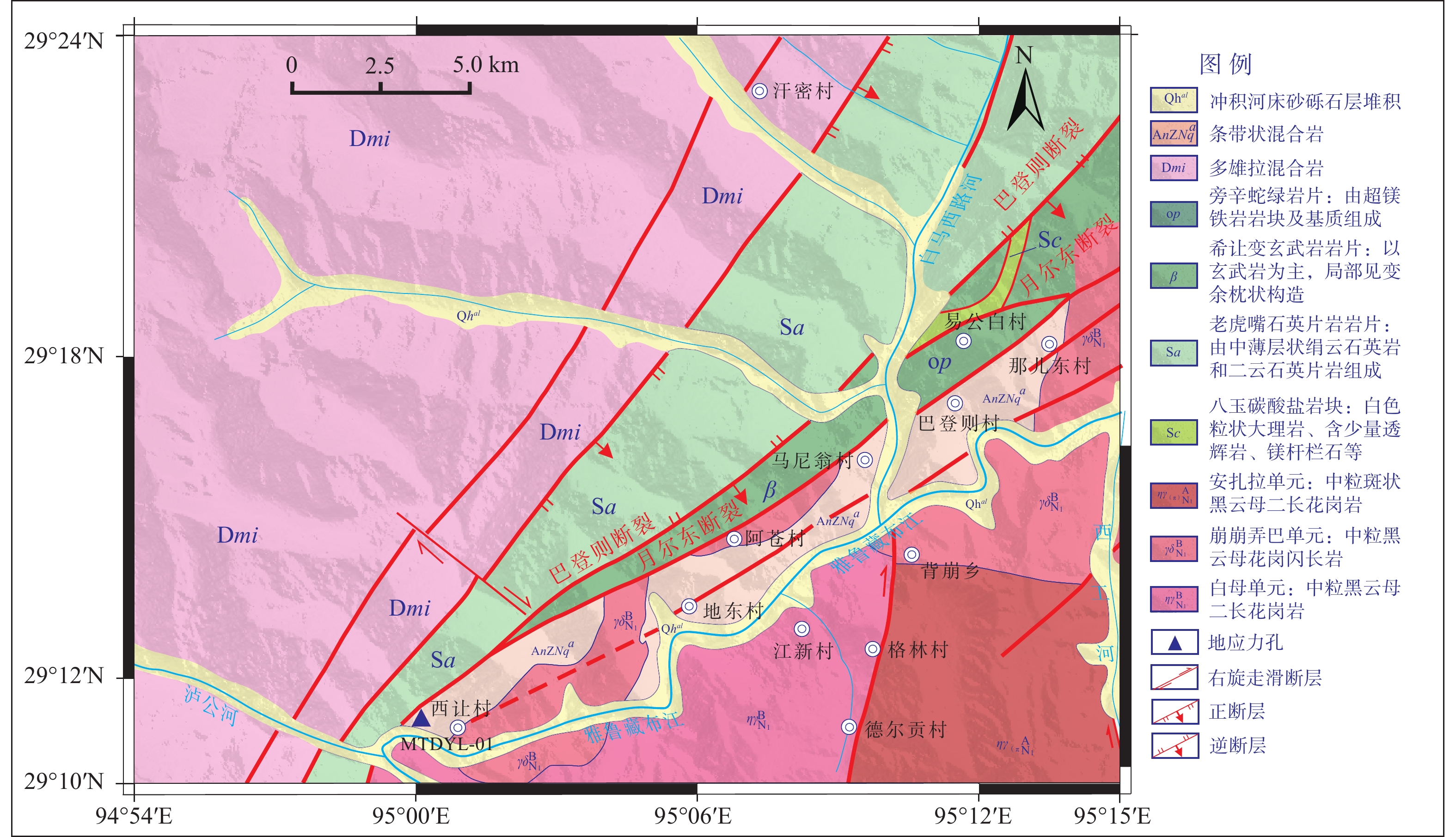
 下载:
下载:

